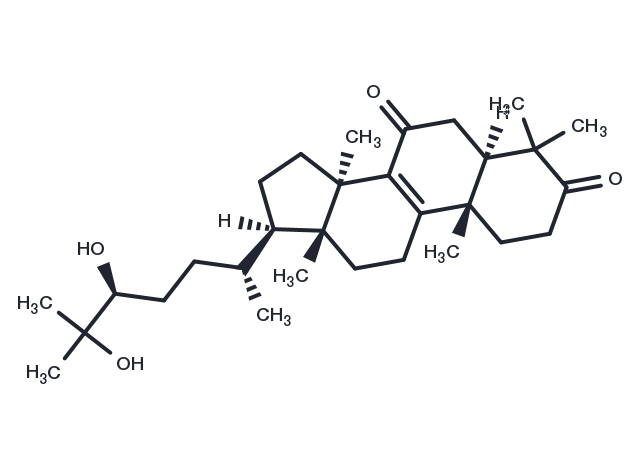Powder: -20°C for 3 years | In solvent: -80°C for 1 year


Lucidumol A has relatively good effect against aldose reductase with IC50 of 19.1uM. Lucidumol A has cytotoxic activity, it reduced cell growth in three human carcinoma cells (Caco-2, HepG2, and HeLa cells) dose dependently with LC50s from 20.87 to 84.36 uM.

| Pack Size | Availability | Price/USD | Quantity |
|---|---|---|---|
| 5 mg | Inquiry | $ 900.00 | |
| 1 mL * 10 mM (in DMSO) | Inquiry | $ 920.00 |
| Description | Lucidumol A has relatively good effect against aldose reductase with IC50 of 19.1uM. Lucidumol A has cytotoxic activity, it reduced cell growth in three human carcinoma cells (Caco-2, HepG2, and HeLa cells) dose dependently with LC50s from 20.87 to 84.36 uM. |
| In vitro | The medicinal mushroom Ganoderma lucidum is well recognized for its effective cancer-preventative and therapeutic properties, while specific components responsible for these anticancer effects are not well studied. METHODS AND RESULTS: Six triterpenoids that are ganolucidic acid E, Lucidumol A, ganodermanontriol, 7-oxo-ganoderic acid Z, 15-hydroxy-ganoderic acid S, and ganoderic acid DM were isolated and identified from an extract of the mushroom. All compounds reduced cell growth in three human carcinoma cells (Caco-2, HepG2, and HeLa cells) dose dependently with LC50s from 20.87 to 84.36 μM. Moreover, the six compounds induced apoptosis in HeLa cells with a maximum increase (22%) of sub-G1 accumulations and 43.03% apoptotic cells in terminal deoxynucleotidyl transferase dUTP nick end labeling (TUNEL) assay (15-hydroxy-ganoderic acid S treatment). Apoptosis was further confirmed by annexin-V staining. Four of the compounds also caused apoptosis in Caco-2 cells with maximum 9.5% increase of sub-G1 accumulations (7-oxo-ganoderic acid Z treatment) and maximum 29.84% apoptotic cells in TUNEL assay (ganoderic acid DM treatment). Contrarily, none of the compounds induced apoptosis in HepG2 cells. CONCLUSIONS: The different responses of the three cell lines following these treatments indicated that the bioactive properties of these compounds may vary from cells of different sites of origin and are likely acting under diverse regulatory mechanisms. |
| Molecular Weight | 472.7 |
| Formula | C30H48O4 |
| CAS No. | 217476-73-8 |
Powder: -20°C for 3 years | In solvent: -80°C for 1 year
You can also refer to dose conversion for different animals. More
bottom
Please see Inhibitor Handling Instructions for more frequently ask questions. Topics include: how to prepare stock solutions, how to store products, and cautions on cell-based assays & animal experiments, etc.
Lucidumol A 217476-73-8 inhibitor inhibit
